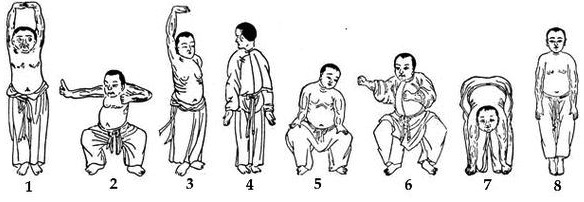What is Qigong?

Qigong (pronounced chee-gong) is an ancient Chinese exercise and healing technique that involves meditation, controlled breathing and movement exercises.
The character "Qi" that makes up the first part of qigong is a difficult word to translate, according to Peter Wayne, an assistant professor of medicine at Harvard Medical School and the research director at Harvard's Osher Center for Integrative Medicine. Qi is a concept from traditional Chinese culture that roughly means vital energy, information, breath or spirit. The second character in qigong, "gong," means cultivation or mastery, Wayne said. Qigong is therefore sometimes translated as "vital energy cultivation" or "mastery of your energy."
There are many forms of qigong practiced throughout the world. Some of these forms involve breathing and meditation to promote spirituality and health while others are more vigorous and include martial arts exercises. Tai chi, a widely practiced mind-body exercise, is sometimes referred to as a form of qigong because it "cultivates, moves and helps manage Qi," according to Wayne.
Qigong vs. tai chi
While they share many characteristics, most people consider qigong and tai chi to be two distinct practices. However, Wayne said that he tends to focus more on the similarities between qigong and tai chi than on their differences.
"The chi in the word 'tai chi' is a different character and has a different meaning [than the 'qi' in qigong]. But the practice of tai chi, in my opinion, is equivalent to a form of qigong. You're training to have more awareness and control over your 'life force' — your physiology or energy," Wayne told Live Science. And some forms of qigong are almost indistinguishable from tai chi, he added.
There are other forms of qigong that look quite different from tai chi, however. These involve simple, slow movements done repeatedly. One of the most basic forms of qigong is Baduanjin qigong, which has eight movements, often called the Eight Pieces of Brocade, or Fabric. (Translations vary.) The movements are: Pressing the Heavens With Two Hands, Drawing the Bowstring and Letting the Arrows Fly, Separating Heaven and Earth, Wise Owl Gazes Backward, Punching With Angry Gaze, Bouncing on the Toes, Big Bear Turns From Side to Side, and Touching the Toes Then Bending Backwards.
While the movements of qigong may be different from those of tai chi in some cases, both practices incorporate strength and flexibility with breathing exercises, focused attention and imagery. The biggest difference between qigong and tai chi has more to do with the public's perception of these mind-body practices than it does with the practices themselves, according to Wayne, who said that qigong carries a stigma in certain societies.
"There are religious cults [in China] that have qigong practices, and there's a lot of political friction between some of these groups and the Chinese government because they're cult-like and esoteric," he said.
Chinese officials denounced one form of qigong, Falun Gong, as a cult in 1999. This resulted in a large demonstration of Falun Gong supporters in Beijing, which prompted the government to outlaw the practice altogether, leading to the arrests of thousands of Falun Gong followers. The subsequent imprisonment and torture of these followers prompted responses from human rights organizations, as well as several resolutions from the U.S. Congress that denounce the Chinese governments oppression of what it calls a "peaceful spiritual movement."

Exercise vs. healing
For many of those who practice it, qigong is an individual mind-body exercise, much like yoga. But there is also a form of qigong that focuses on healing others.
"The qigong practices you do yourself can be distinguished from what's called 'external qigong,' which is a practice that looks like distant Reiki healing," Wayne said.
In external qigong, a qigong therapist first diagnoses patients according to the principles of traditional Chinese medicine (TCM) and then uses "emitted Qi" to facilitate healing, according to a 2010 paperpublished in the American Journal of Health Promotion, which reviewed the health benefits of qigong and tai chi.
The authors of the paper wrote that "both internal Qigong (personal practice) and external Qigong (clinician-emitted Qi) are seen as affecting the balance and flow of energy and enhancing functionality in the body and the mind." However, the authors' review of qigong's health benefits was limited to the personal practice of qigong. There is no scientific evidence to support the efficacy of external qigong in treating health conditions or disease.
But research into the broader, related field of biofield therapy is ongoing, as Wayne pointed out. One recent pilot study, published in the Journal of Alternative and Complementary Medicine, reviewed randomized controlled studies of biofield therapies — including external qigong, Healing Touch, Johrei, Reiki, and Therapeutic Touch — and found that two thirds of the 18 trials reviewed demonstrated at least partial effectiveness. This led the authors to conclude that further research in this area is warranted.
Scientific support of qigong
Unlike tai chi, qigong has not been widely studied for its health benefits, according to Wayne, who noted that more high quality research is needed before any definitive statements about the efficacy of qigong can be made. However, personal practice of qigong is not considered unhealthy, as it typically entails gentle movements and relaxation.
One of the largest studies involving qigong is the 2010 review of 66 studies totaling 6,410 participants, which was published in in the American Journal of Health Promotion (see above section on exercise vs. healing). Though the researchers combined qigong and tai chi studies in their review, they did find various positive results suggesting that both forms of exercise improve bone health and balance.
A 2007 study published in Journal of Hypertension found that qigong exercise had a mildly positive effect in lowering blood pressure, though the authors did state that further research was needed to confirm these results. The authors of a 2007 study& published in the Journal of Alternative and Complementary Medicine issues a similar statement after concluding that qigong exercise has a mildly positive effect in controlling diabetes.
Research is ongoing into the efficacy of qigong as a complementary treatment for cancer patients, Wayne said.
Follow Elizabeth Palermo @techEpalermo. Follow Live Science @livescience, Facebook & Google+.
Additional resources
- The National Center for Complementary and Integrative Medicine's video on tai chi and qigong.
- More information on qigong from the National Qigong Association.
- Background information on Falun Gong from Encyclopedia Britannica.
Sign up for the Live Science daily newsletter now
Get the world’s most fascinating discoveries delivered straight to your inbox.

Elizabeth is a former Live Science associate editor and current director of audience development at the Chamber of Commerce. She graduated with a bachelor of arts degree from George Washington University. Elizabeth has traveled throughout the Americas, studying political systems and indigenous cultures and teaching English to students of all ages.










